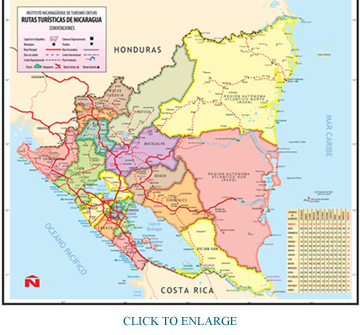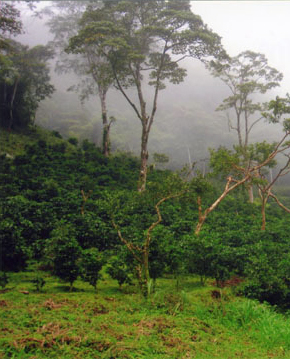NICARAGUA - THINGS TO DO - PAGE ONE

Where to begin? South of the capital Managua is more developed for travelers so it is definitely 'tourist' friendly. Southwest Nicaragua offers a number of of designations and enticing sights to discover such as the colonial city of Granada, the artisan town of Masaya, the natural wonders of La Isla de Ometepe, and the relaxing beach front town of San Juan del Sur. The northern part of Nicaragua is less explored, open to adventure and excitement. Here you can travel to the other colonial jewel, León. You can also travel east via a prop plane from Managua, to visit the Caribbean coast town of Bluefields or to the Corn Islands in the turquoise waters of the Caribbean. So many decisions to make. Let's start by going north!!
The Northwestern Plains of Nicaragua
The northwest is the most populated and agriculturally rich section of Nicaragua. The area is known for it's sweltering heat so make sure to always carry plenty of bottled water. Explore the Cordillera Los Maribios, a massive chain of active volcanoes stretching northwest from Lake Managua (Lago Xolotlán) all the way to the Gulf of Fonseca. Hike up any of the volcanoes and if you're a risk seeker, instead of hiking back down you can try your hand at snowboarding down a volcano. In the northwest there are also beautiful beaches that line the Pacific coastline.
The region's two major cities are León and Chinandega. León is home to numerous cathedrals, including the largest cathedral in Central America, the Catedral de León. Take a tour of the cathedral's rooftop and its 34 domes or tour the seven underground cellulars of the cathedral. Leon features numerous museums such as La Casa de Cultura and La Casa de Rubén Darío. Being a university town, there are many books stores and cafés where the buzz is almost always about politics. Located southeast of León, are the ruins of León Viejo on the shores of Lago Xolotlán. The ruins feature the original town of León that was destoryed by Volcán Momotombo in 1610. The site is open seven days a week from 8 am to 5 pm. Public transportation from León to the ruin is offered as a bus stops in La Paz Centro at 8 am and 11 am. Nearby León Viejo is Volcán Momotombo and Momotombito island. If you want to escape the heat, you can take a 20 minute taxi ride from León to Poneloy, the most popular beach in the area.
The town of Chinandega has few tourist attractions. Nevertheless, this regional capital is a perfect base camp for volcano and beach expeditions. This particular area of the northwest is the hottest and driest in Nicaragua. Chinandega is home to beautiful churches and in the central park you'll find full-grown alligators. West of Chinandega is the barrier island and port town of Corinto. Corinto is fairly well developed for tourists offering simple hotels and seaside restaurants. South of Chinandega is Chichigalpa home town of the Compañía Licorera, manufacturer of world famous Flor de Caña rum and beers Toña and Victoria. Tours of the distillery are available by calling the plant in advance.
Northern Nicaragua, Estelí and the Segovias
North of Managua, Sébaco Valley is lush with rice and sorghum fields. From this point the highways works its way upward to the city of Estelí, then continue through mountains and valleys dotted with peaceful rural villages. The north country is where you'll discover ruins of ancient cities and deep water pools fed by cascades of cool mountain water. In Estelí you can admire the town's inspiring collection of murals and sample fine cigars. In fact, for those who are cigar aficionados, the tobacco grown in the region comes directly from precious Cuban tobacco seeds. One grower told Cigar Aficionado that Cuba and Nicaragua "have the most fertile dirt in the world for tobacco. It's almost like God said, 'I'm going to pick these two countries and I'm going to use them for tobacco.'"
North of Estelí is the Miraflor Nature Reserve. A visit to Miraflor is like a trip back in time. Miraflor has something for everyone. Miraflor is one of the richest and most unexplored orchid regions in the world. The highest point in Miraflor is the mature cloud forest of Bosque Los Volcancitos which it's inhabitants include howler monkeys and quetzals.
Further north, Ocotal is the last major settlement before the Honduran border at Las Manos. Ocotal is located in the department of Nueva Segovia. Make sure to visit the Iglesia de Nuestra Señora de Asunción, a beautiful church in which construction began in 1804 and wasn't fully completed until 200 years later!! A view from the church looks out over a gorgeous central plaza.
Matagalpa and the Jinotega Highlands

Matagalpa and Jinotega are towns northeast of Managua. The department of Matagalpa is the most mountainous in Nicaragua and the region provides the perfect climate for the cultivation of coffee. When visiting Matagalpa, make sure to spend some time in the Parque Darío and tour the third largest cathedral in Nicaragua built in 1874. La Catedral de San Pedro, constructed in 1874 is noteworthy for it's baroque style and heavy bell towers.
Jinotega is an area replete with fragrant valleys of orange groves. Jinotega has virgin forest areas with small lagoons, stately mountain ranges and some of Nicaragua's finest rivers. Jinotega is the gateway to the wide open expanses of the east. Northeast of Jinotega is the Bosawás Biosphere Reserve. Besides unequaled stretches of cloud forest, Bosawás contains tropical humid forest, rainforest and a wealth of disparate ecosystems. Most of Bosawás remains unexplored, unmapped, and untamed. Bosawás is a treasure, an immense genetic reserve of species that have vanished elsewhere in Mesoamerica, including jaguars and the gorgeous scarlet macaw, to name a few. The entry town to Bosawás is Siuna. It's reminiscent of the towns like Tombstone in America's wild, wild west. Any trip in Bosawás is a serious undertaking and should not be attempted without proper supplies. The best way to get there is to take a domestic flight from Managua to Siuna or the town of Bonanza.
